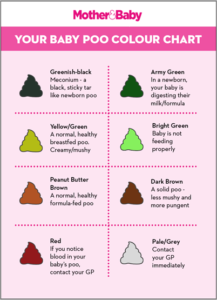
The color of your baby’s poop says a lot about their health.
Certain colors and even textures mean potentially serious conditions that need prompt medical attention.
It’s impossible to not see your baby’s poop on a daily basis, but even then, it’s very important to always be mindful of what colors it typically is and if there are any new changes to the color or texture.
Safe and Worrisome Colors of a Baby’s Bowel Movements: a Basic Rundown
“Baby poop can be any color!” says Dr. Lisa Lewis, MD, a board certified pediatrician in Fort Worth, Texas, and author of “Feed the Baby Hummus, Pediatrician-Backed Secrets from Cultures Around the World.”
But not every color means nothing’s wrong.
“Early on, the dominant color is green and yellow,” continues Dr. Lewis.
“Don’t worry about yellow, even though as an adult yellow signals a change in the intestines such as an ingestion of a new different type of food. Yellow stool in an adult could also indicate an intestinal problem.
“Formula-fed babies may have thick green, yellow or clay [dull orange] colored stool.
“Dangerous baby poop is a bloody stool, particularly stool that looks like red currant jelly or black coffee grounds.”
The coffee ground appearance is indicative of old blood, higher up in the GI tract, while a bright red appearance reveals fresh bleeding, which would be lower down in the GI tract.
“Stool that looks like red currant jelly is associated with a dangerous condition called intussusception. Although rare, it is life threatening if not corrected by a medical procedure or surgery.”
Intussusception is when part of a baby’s intestine slides into a nearby part.
“Dangerous baby poop can also be in the form of diarrhea (usually yellow, green or brown) WITH blood or mucous,” says Dr. Lewis.
“Persistent diarrhea can be associated with dehydration. The presence of blood or mucous in the stool may indicate a serious intestinal problem such as bacteria in the gut.”
Bowel Obstructions and Stools
Dr. Lewis explains, “Most obstructions will cause the baby to pass little or NO stool, and are considered an emergency.
“A baby with an obstruction will typically vomit, become lethargic and have an absence of stool. Any suspicion of obstruction, dehydration or bacterial diarrhea should be seen promptly in the emergency department.
“Typically, unwanted bacteria in the stool will result in diarrhea. Bacterial diarrhea will be frequent and may have blood or mucous.”
The word “obstruction” may bring to mind cancer. A malignant tumor as a cause for a baby’s bowel obstruction is extremely rare.
Cancer is towards the bottom of the list as a possible cause for a baby’s bowel obstruction.
And sometimes, the obstruction isn’t structural or mechanical, but considered “pseudo.”
Other Causes
• Abdominal surgery complications
• Adhesive scar tissue from surgery
• Appendicitis
• Fecal impaction
• Foreign body from ingestion
• Gallstones (rare)
• Hernia
• Imbalance of electrolytes or minerals
• Infection (bacterial or viral)
• Intussusception
• Kidney disease
• Lung disease
• Medication side effects
• Twisted intestine (volvulus)
Baby Poop Color Guide Schematic
Refer to this handy color coded and descriptive guide for more details about what colors of a baby’s stool are normal and what are signs of a serious problem.











































